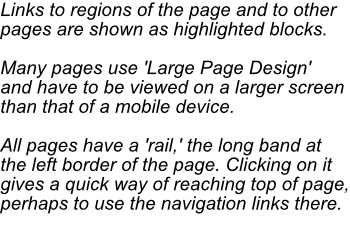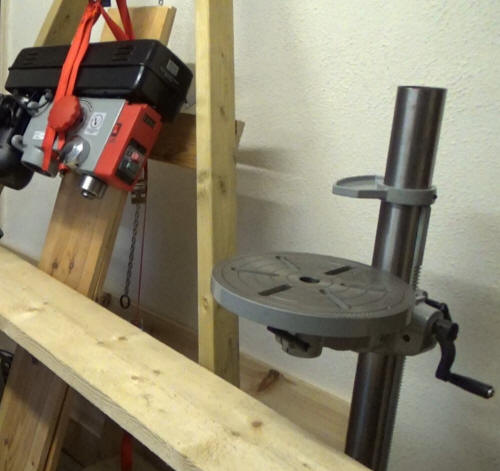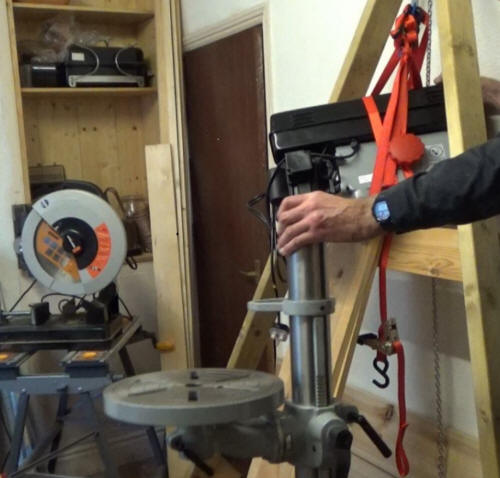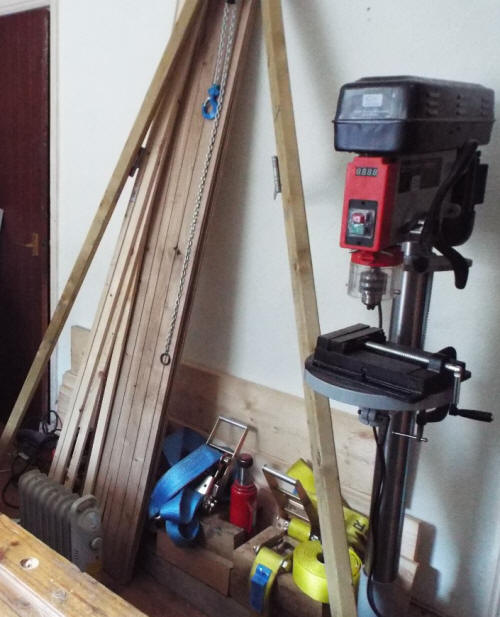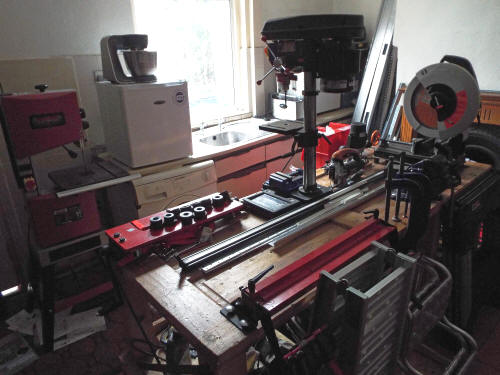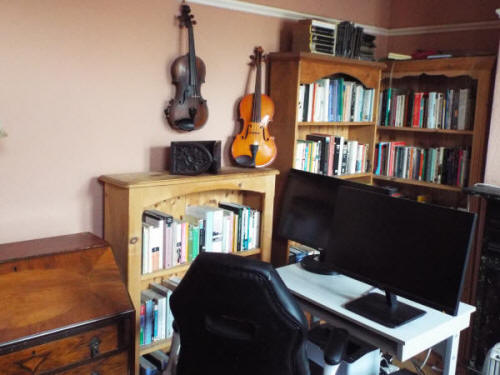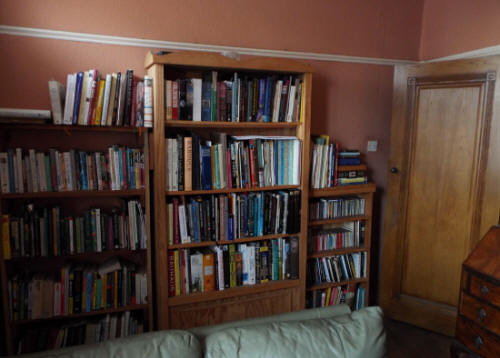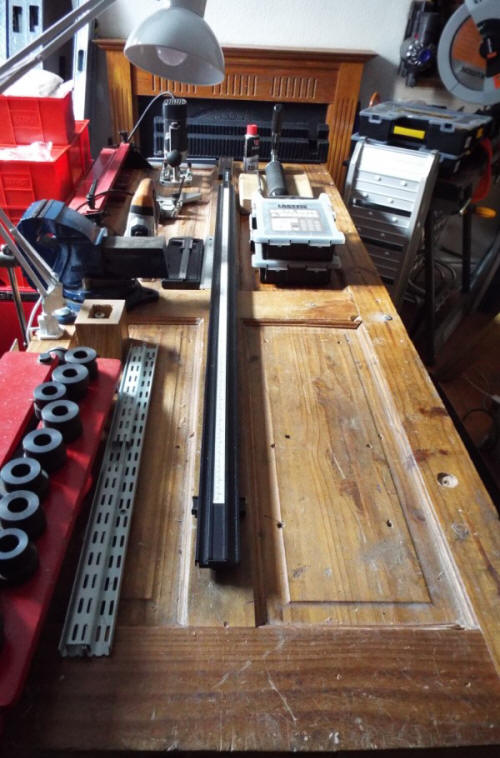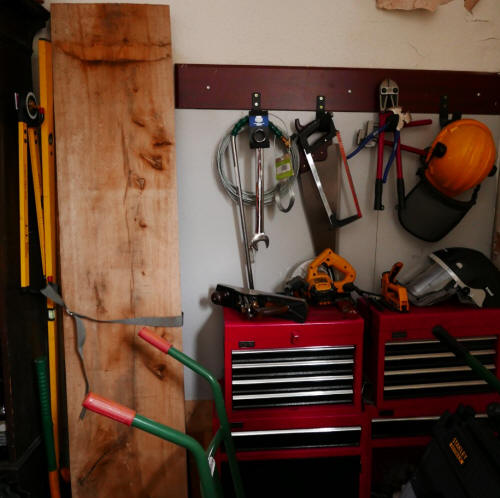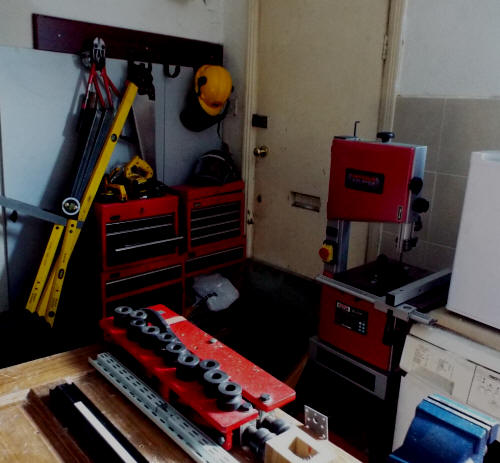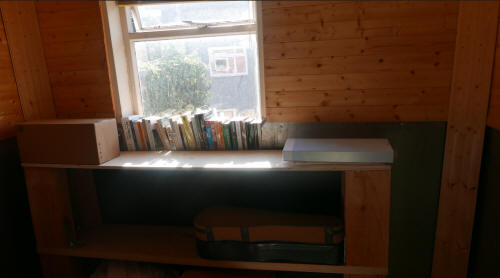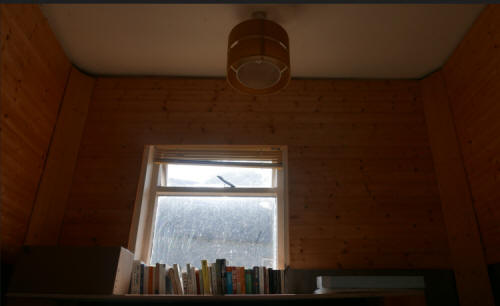Van - campervan conversions and mobile architecture
The first conversion here is a conversion of my Volkswagen Caddy van. The second is a conversion of the Citroen Berlingo van I used to drive.

Photographs of the prototype, 28 September, 2020, here, parked in the street, followed by photographs of the campervan at a campsite in Derbyshire.

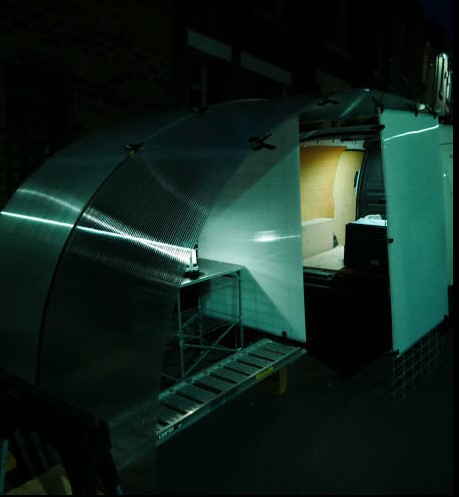
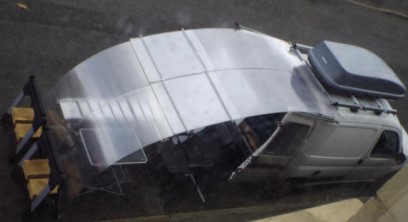
Below, the van with campervan extension at a farm campsite near the village of Great Longstone, Peak District, Derbyshire. During my stay, I made changes to the design which don't alter the appearance very much but which are improvements. Before the changes, the open rear doors helped to support the two vertical polycarbonate sheets nearest to the doors. After closing the doors, these sheets lose the support of the doors. I already had a solution available, to ensure that the vertical sheets form a self-supporting structure - the use of guy ropes, attached to the metal mesh panels which are linked with the polycarbonate sheets. This allows the doors to be closed without the structure collapsing. I used the 'furniture' inside the extension to give support to the vertical polycarbonate sheets - not the chair shown here, but the kitchen unit in front of the chair , which was moved to the back of the extension, next to the door shown, the driver's side of the vehicle, with clamps to ensure a secure coupling. The long, low horizontal aluminium component to the left of the kitchen unit didn't need to be moved. The end nearer to the back of the van, which can't be seen here, was already in the correct position. Clamps ensure a secure coupling with the metal mesh panel next to the vertical polycarbonate sheet on the left side - the passenger side - of the vehicle.
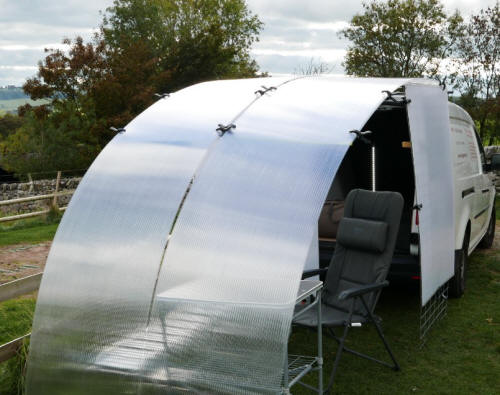
Below, photograph of part of the campervan extension, the part not visible in the photograph above - the vertical polycarbonate panel connected to a metal mesh panel, which is next to the passenger side rear door - and, also another vertical polycarbonate panel and metal mesh panel linked with it. Photograph also taken at the Great Longstone campsite. The dark horizontal towards the lower edge isn't part of the campervan extension. It belongs to farm fencing.
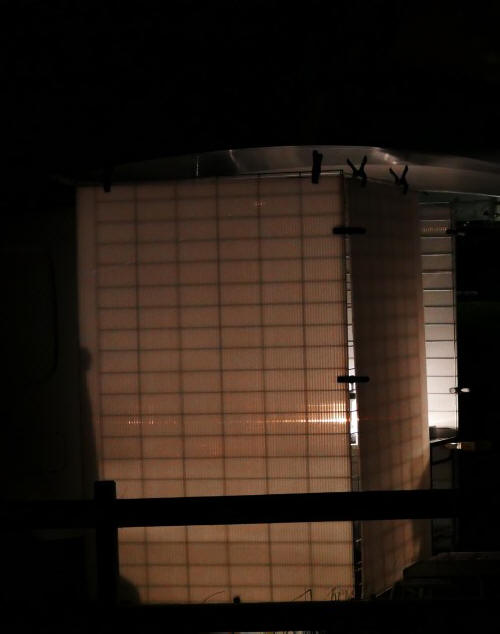
Below, a wide-angle photograph taken from much the same position:
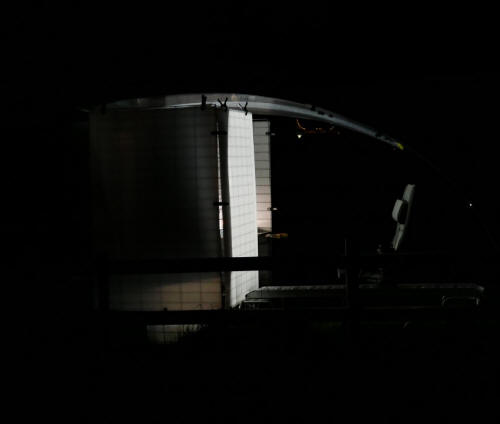
Below, photographs showing the components of the campervan conversion including, on the left of the van interior, the wire mesh panels and polycarbonate sheets which form the straight walls of the extension. All these are easily stored and transported inside the van, leaving plenty of space for the other things needed for camping. The polycarbonate sheets shown on the ground fit into the van easily when they have been formed into curves. At the site, these sheets are connected in pairs with clamps, curved and then put in place to form the rear curved walls of the extension. The upper pair are held in place by the rear roof racks of the van and the lower pair can be held in place by a variety of methods - small ground anchors, tent pegs or by improvised objects - at this campsite, I made use of a concrete block already at the pitch and a box from inside the van.
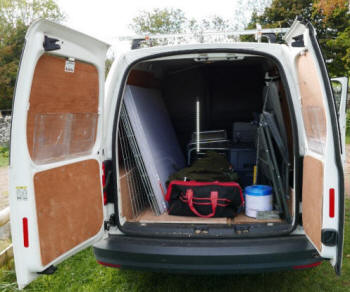
Campervan conversions give rise to very interesting design problems and opportunities, aesthetic as well as functional. I've no intention of using this Volkswagen Caddy van as a campervan at all often. I haven't used a campsite for very many years. I've hardly left Sheffield for over ten years. How could I find the time?
Tent camping was an interest over a long period of time but a long time ago. I've camped in a wide range of settings, in the Lake District and other parts of the UK, in various European countries, including the Irish Republic, and in Canada. Amongst my experiences, camping in bear country in Canada - a young bear did come near to my tent - this was at an organized campsite, not in the wilderness. I came to cross-country skiing in my thirties but I skied over a long period of time, with an interest in cross-country downhill. My best skiing was in the Derbyshire Peak District and the Yorkshire hills near here but I've skied in the Alps twice on cross-country skis. I travelled to the ski areas by train and when I arrived, I looked for a campsite and pitched my tent. I've camped without a tent on occasion. When I reached the Isle of Skye, I couldn't find a campsite before nightfall. I used the simple bivouac bag I had with me and slept in the open, on the soft heather.
This current project was nearing completion when the Coronavirus epidemic started. The project was halted, of course. Like the earlier project, this one involves changes to the van which can easily be reversed: the van can easily be used for transporting materials and all the other typical uses of a van as well as the typical uses for a campervan.
My Citroen Berlingo van was replaced in Spring 2020 by a Volkswagen Caddy. I began to work on a campervan conversion for the new van which made use of some of the features of the Berlingo conversion, such as the long, curved polycarbonate sheets but completely new features as well, in particular, vertical polycarbonate walls which form the 'inner ' of the campervan, the part which gives privacy. These polycarbonate walls are strengthened with wire mesh panels.
It took me a long time to arrive at this design but, after erecting the prototype - not at a campsite - it seems to me a very sound design, although there are minor issues which will need improvement. The design has advantages over the Berlingo conversion, in particular the fact that the whole of the 'added structure' can be made self-supporting, after detaching the curved polycarbonate sheets at their upper end and anchoring them in the ground, a process which takes very little time. This isn't, obviously, a campervan which can be driven as a whole. Only the Caddy van itself can be driven. The structure which makes up the conversion has to be erected like a tent, but I've made improvements to the erection process used in the Berlingo conversion. The erection of the structure is easy.
A prototype will lack some of the features of the finished product (a 'finished product' can still be modified and improved.) This is the case here. In the trial run, I put in place the tall camping table and the aluminium bench which can be used for seating and for supporting a range of things, such as the portable stove I have, which runs on petrol. Other camping eq The portable toilet, enclosed in a plastic storage container, was inside the van. I didn't put in place the camping mattress and sleeping bag. In this prototype, the oak flooring is without varnish. Varnishing will enhance its appearance but has no relevance to the design essentials, even though some aesthetic considerations in this case belong to the design essentials, together with the essentials of strength and safety. Amongst the essential improvements needed - eliminating the small gap between the two long curved polycarbonate sheets. A horizontal sheet, also supported by a wire mesh panel, protects the inner structure from rain. It wasn't put in place for this trial but has been used during preliminary work.

Above, the design near to completion, construction of prototype. The structures with four oak sections at the left of the image keep the rear of the curved polycarbonate sheets in place - here, the van is parked at the side of the road. At a campsite, ground anchors (or, alternatively, strong tent pegs) driven into the ground would serve the same purpose.

Above: at night, illumination provided by a lantern inside the van. The curved polycarbonate sheets aren't closed at the sides. The inner structure gives protection on three sides to the rear entry to the van. On two of the sides, not visible here, the open rear doors of the van provide protection, with additional protection provided by polycarbonate sheets. The third, longer side, can be seen here. Slightly sloping polycarbonate sheets form this side. The sheets can be moved in metal grooves on the ground, allowing access to the inner structure and the back of the van. The long aluminium structure, on two metal supports, has various uses. One use is as a long table. Another is for supplementary seating (a folding chair is also available.) There's another, higher table in the foreground. This is used as a stand for the cooking stove - the one I have uses unleaded petrol. There's storage space underneath it for cooking utensils and cooking indredients. Illumination is provided by an electric lantern, inside the inner structure here. I also have available a lantern which runs on unleaded petrol. Inside the inner structure, a portable toilet.

Above, another view of the parts shown in the image above. This image also shows one of the open vans, but not the polycarbonate sheet which is attached to the door. The inner structure can be erected very quickly after arrival at a camp site. It doesn't give a large available area, but it does provide a very useful area - complete privacy if needed - otherwise, some of the polycarbonate sheets making up the longer wall can be opened - shelter from wind and rain, with the benifts of insulation from polycarbonate, room to stand, room to sit, ample space for sleeping. Sleeping is inside the van, using a camp mattress and sleeping bag, but most adults will be too tall to sleep in the van without feet, or more than feet, sticking out. This extension allows the tallest people to use the van for sleeping in comfort.
The curved polycarbonate extension, made up of four lengths of polycarbonate, is shown clearly here. The extension, which fits over the inner structure and is obviously much larger, can be fitted quickly, but, unlike the inner structure, not in high winds. (Once erected, though, it can withstand high winds.)
I've extensive experience of constructing buildings using polycarbonate sheets. I've learned the techniques necessary to build structures that do withstand high winds - not, of course winds which are exceptionally strong, the kind that can easily damage conventional buildings. For this extension, unlike the buildings which incorporate curved polycarbonate, the use of guy lines for added security is possible, advisable, in high winds. There are eight metal bars in four pairs, with bolts and nuts which when tightened allow the bars to grip the overlapping sheets and keep them together.
Guy lines can pass through spaces at the four outer ends and lead to the ground, where they're anchored with tent pegs or, on hard surfaces, an alternative anchoring system.

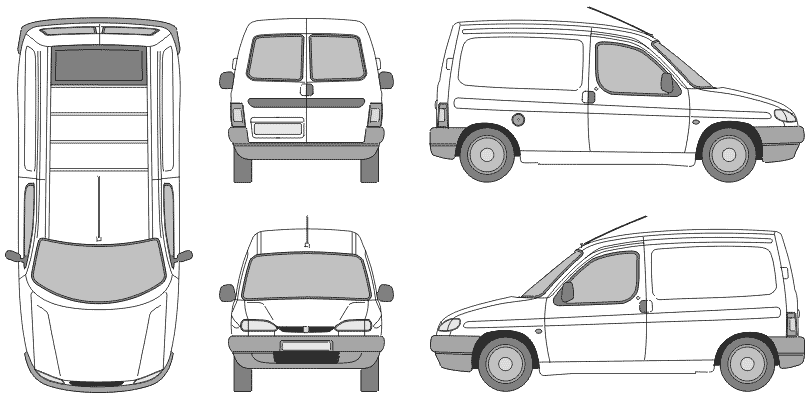
Despite the size of the extension, all the components fit neatly into the back of the van and take up very little space. The straight and curved polycarbonate sheets which are the main components for the design can even increase the general storage area - they allow other things to be stored more efficiently, more easily. The polycarbonate sheets also insulate the van when they are transported and stored, particularly the straight sheets at the sides and the top. A great deal of space is available for other things, including camping equipment, such as a portable toilet and the metal folding unit for food preparation and cooking - it can also be used for additional seating.
At the campsite, the curved polycarbonate sheets are secured by tent pegs or ground anchors, if the van can be parked on grass or some other soft or not too hard surface. If it's parked on concrete or some other very hard surface, then I have methods available for securing the lower parts of the polycarbonate sheets. On the street here, the curved polycarbonate sheets are kept in place with these trestles and oak blocks to give greater weight.
Above, a view of the inside of the van, showing curved, clear polycarbonate sheets, which form the long curved section of the campervan, straight, opaque polycarbonate sheets at the side, which form the slightly sloping long side of the inner structure, and straight, clear polycarbonate sections, supported inside the van by crossed diagonals near the roof - these diagonals have another function, as tracks on the ground. The opaque polycarbonate sheets can be moved along these track, allowing entry into the inner structure.
The campervan can be used with the inner structure only erected, the curved polycarbonate as well as the inner structure erected - and, also without the inner structure or the curved polycarbonate used to form the extension. In this case, the van is used as it is, and the polycarbonate is stored in the wan. Sleeping is inside the van with the rear doors closed. Taller people will sleep in a diagonal position on the plywood base visible here, with a camping mattress to give greater comfort. The straight polycarbonate sections stored at the sides and the roof don't get in the way, but the curved polycorbonate sections certainly would get in the way. For sleeping in the van, the curved polycarbonate sheets are stored curving from the roof towards the front of the van, rather than in the position shown in the image above, curving from the roof towards the rear of the van. It takes only a very short time to rearrange them.
In the image at the top of this column, the roof box appears to be small in comparison with the size of the campervan extension. It is small in comparison, but the roof-box is one of the larger roof boxes, with a volume of 470 litres.
Photographic images, of course, are ways of capturing and preserving. The curved polycarbonate and the straight polycarbonate sheets of the campervan extension have a practical use but for me, they capture and preserve the architectural lines of the greenhouse I constructed in one of my allotments.
The campervan extension:

One of the polycarbonate extensions of the triangular greenhouse:
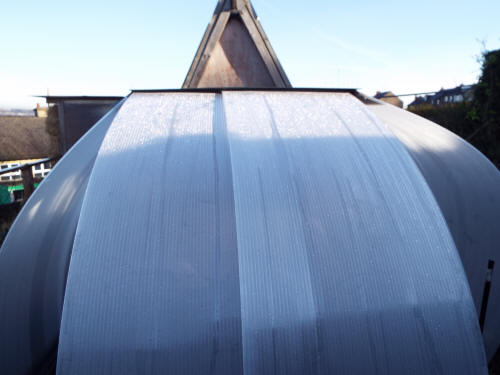
Another view of the greenhouse and one of the curved extensions. The greenhouse and these extensions have roofs of sheet metal.
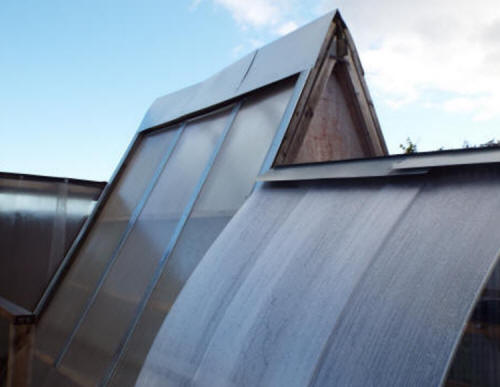
Unlike loose straw, straw bales aren't a significant fire risk. I've worked so hard at securing the allotments that intruders would find it very difficult to break in.
A new idea, which can potentially lead to a new design, is the start of a process which is usually very time consuming. Implementing a design may well need the buying of new components and tools and sometimes machinery. A new idea may be succeeded by a second or third idea. To make the design work, it may be necessary to come up with other ideas, to overcome obstacles which arise in the process of realizing the idea. A main idea may have to be abandoned, replaced by another idea, which may have to be abandoned as well. The van-campervan extension, described in the column to the right, started with an extension roof made of varnished plywood. The roof was quite heavy and it was essential to ensure that the roof couldn't possibly fall.
I don't share the common disdain for 'health and safety.' Some of the designs on the site are intended to be contributions to safety, for example the very simple design which makes use of plastic strips attached to the corners and edges of sheet metal to protect the user from injury, and the low-level sheet metal working bench which eliminates the dangers of lifting heavy sheet metal sheets, particularly when one person carries out the lifting.
To ensure that the plywood was secure, I designed and constructed long metal supports, attached to the roof bars of the van. These metal supports projected beyond the rear of the van, a distance of a fraction under 1m. Regulations in this country permit loads which project by this distance, without the need to attach hazard warning signs. The metal supports were high enough not to be a danger even to tall people who walked under them.
I decided that although the system worked, it was too cumbersome. I replaced the plywood roof with a much longer roof made of polycarbonate. The final design makes use of this system. I spent a long time working on two side walls made of fabric, in this case, acrylic canvas. The fabric was kept in place with Neodymium magnets. Again, this system worked, and worked very well. I eventually abandoned it because of appearances - the fabric tended to look too crumpled to be acceptable - and practicality. The fabric excluded light, and the inner structure was too dark. (This was also an objection to the use of plywood, obviously light excluding.) Below, two views which show the way fabric was used in the design which was superseded, interior and exterior. The exterior view doesn't show the many small, circular magnets which pressed the fabric to the bodywork of the van.
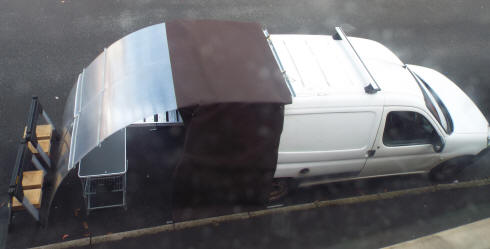
I eventually adopted the system which still stands. The two rear doors are open, and supplemented with clear polycarbonate sheets attached to the doors. The sheets give more insulation than the fabric and allow much more light to enter.
Some of the techniques I used in the designs which were abandoned turned out to be very useful in implementing the design I've adopted. The two long metal components, each of them made up of two sub-components, which supported the plywood roof turned out to be very useful. When shortened, so that they didn't project beyond the back of the van, they solved the problem of keeping in place the upper ends of the curved polycarbonate sheets. The sheets fit into a metal section which is the same, in essentials, as the longer metal sections. The Neodymium magnets I bought to keep the fabric pressed against the sides of the van keep in place the opaque ('opal') polycarbonate panels which are part of the inner structure. Magnets are used for fixing the line which supports the curtain at the front of the van, behind the driver's seat and passenger seat.

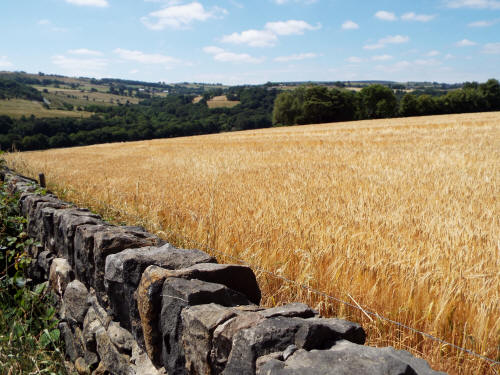
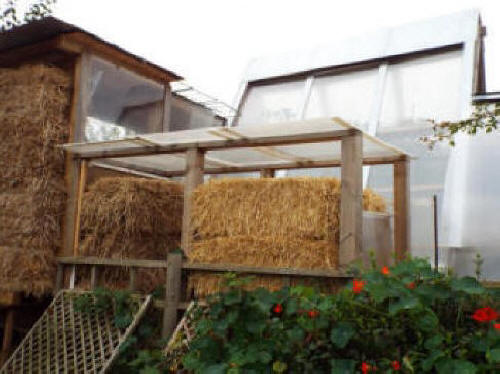

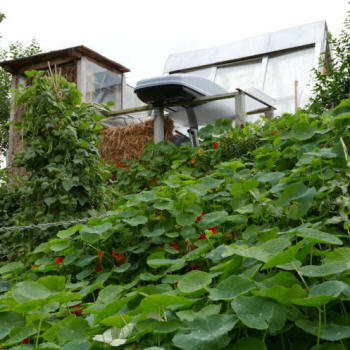

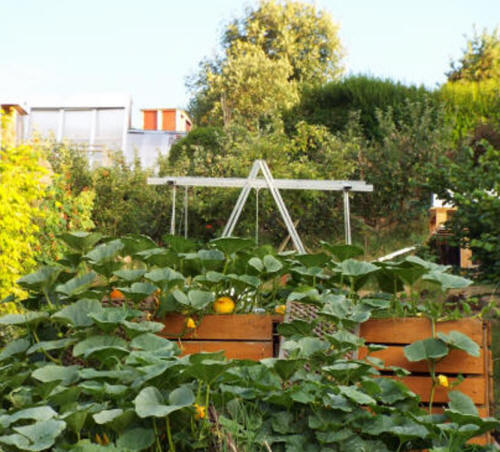
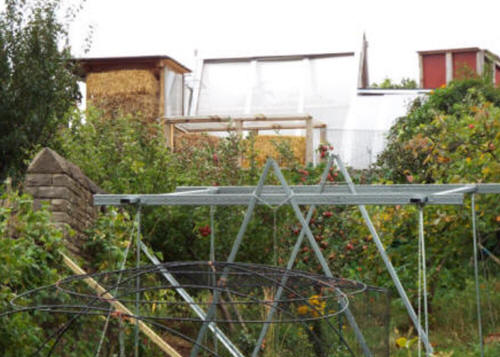
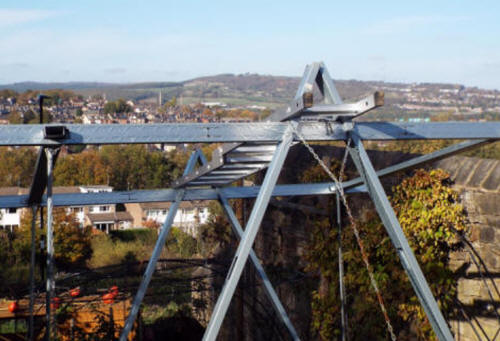
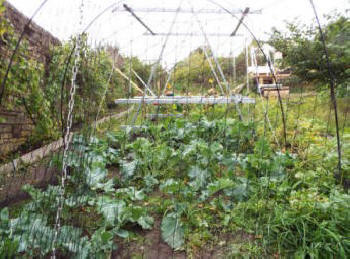
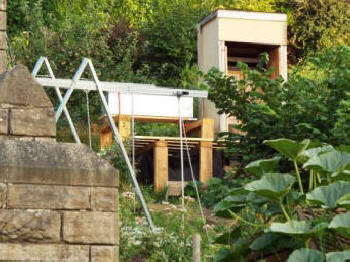
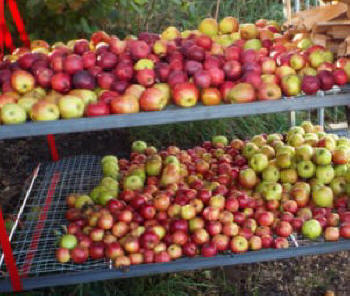



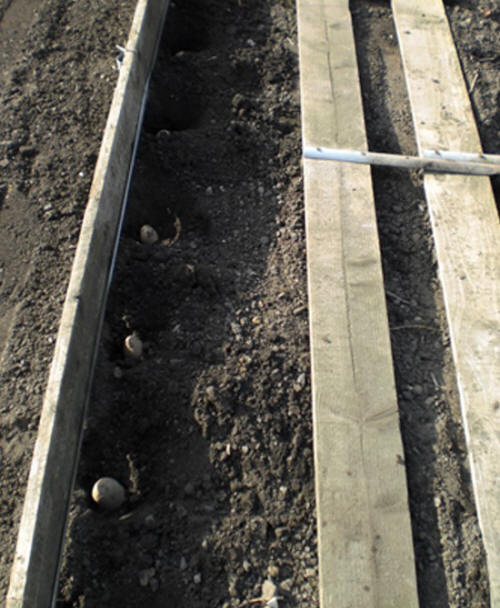
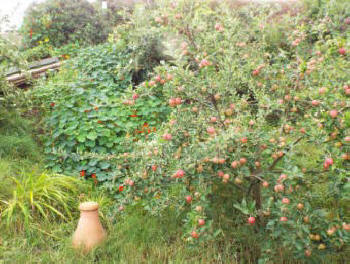
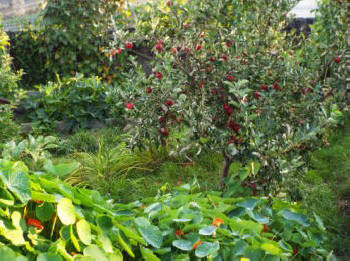
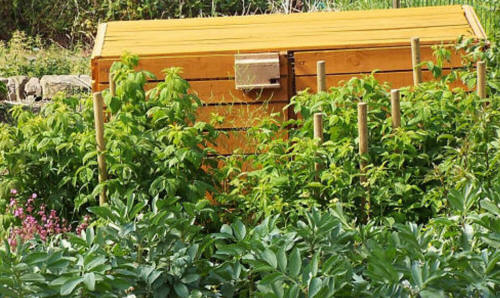
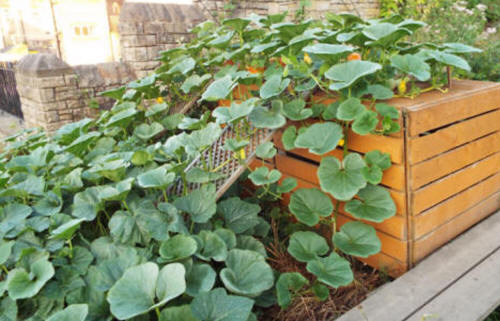
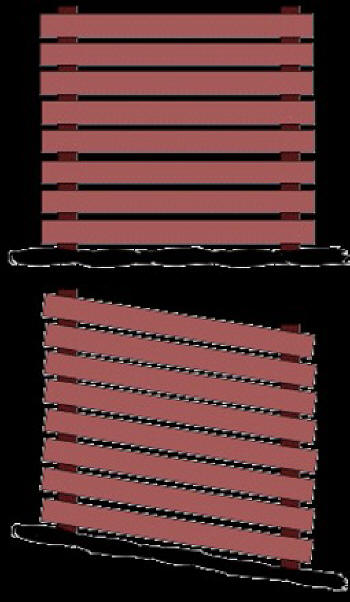

/DSCF2021.jpg)
